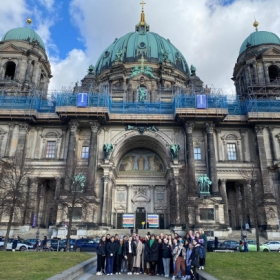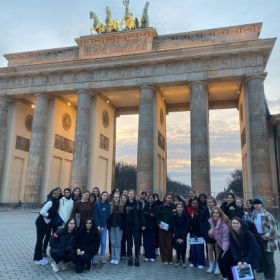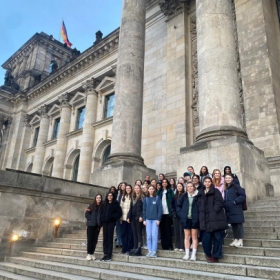Wilkommen In Berlin!
Published by Edgbaston High School for Girls on Monday 6th of March 2023
Just before half term, History and German GCSE and A-Level students took the exciting opportunity to travel to Berlin, visiting some of the world’s most well-known landmarks and learning about the riveting history the city holds. Students Nethara R and Millie H report.
We started our trip straight away after landing in Berlin, starting with lunch at Potsdamer Platz, which was rebuilt during 1980’s into a modernised public square after being left as a wasteland from the time of the Berlin Wall. We immediately headed off to the Reichstag, catching a magnificent view of the Holocaust Memorial and the Brandenburg Gate as we walked past them. The Reichstag is a historic government building, famous for serving as parliament for the German Empire and Weimar Republic, heavily damaged by the Second World War and rebuilt since 1994, it now functions as the seat of the German federal Parliament. We were able to see a stunning panoramic view of the city from the top and from inside the Reichstag Dome, designed by the British architect Norman Foster. We stopped by the Berlin Brandenburg Gate, built in the 18th century, it is Berlin’s only surviving historical city gate, and now a powerful symbol of the re-unified Germany after the demolishing of the Berlin Wall. Finishing off the day we had a lovely German cuisine near the gate.
On the second day, we had an early start with a ‘Walking tour of Berlin’ with our tour guide Jörg, who filled our students with historical knowledge of Berlin. We talked in depth about the following: Berlin Brandenburg Gate, and how it linked to the Cold War, the Reichstag (famous fire in the early 20th century which was most likely started by the Nazis), the bunker where Hitler stayed in the last few weeks of his life (with his close acquaintances) which has now been turned into a degraded car park, Detlev-Rohwedder-Haus and its importance in German history as well as the astonishing yet successful attempt of the crossing the Berlin Wall with a ‘homemade’ zipline of one German family to where some of the Berlin Wall is still standing. Jörg discussed the political and social problems caused by the Berlin Wall and the tension between the West and East sectors of Berlin. Passing along the Trabi museum (popular car in East Berlin during the Cold War), we finished our tour at Checkpoint Charlie, the best known checking point of the Berlin Wall between the East and West, named by the Americans who monitored the checkpoint. After lunch, we headed towards the Berlin Wall Memorial, learning about the effect the Cold War has on the Berlin citizens - especially the East Berliners - and those who were desperate enough to sacrifice their lives to cross the Wall. Around 140 known people died trying to cross the wall in Berlin. Some victims were just children who were still in school. We then visited the TV Tower and had yet another panoramic (but higher) view of Berlin at the observation deck - which is a whopping 203 metres high - before finishing off our day at an Italian restaurant.
On day three of our trip we went to the Stasi prison. This was an institution to detain people who opposed the communist-controlled German Democratic Republic (GDR). It was used from 1946 to 1990 to torture and scare anyone who opposed the GDR. These prisoners were kept in tiny cells and were subjected to torture to extract confessions. After the construction of the Berlin Wall in 1961, the prison was primarily used to house those who wished or attempted to leave East Germany, although political prisoners were also held there. After the fall of the Wall, the communist regime and the subsequent reunification of Germany, the prison closed in October 1990.
Moving on from the Stasi prison, we headed off to the Topography of Terror which was situated where the original headquarters of the Gestapo (the secret police of Nazi Germany), the high command and the security service of the SS, and from 1939 the Reich Security Main Office. The museum informed us all about how the Nazis rose to power and the crimes that were organised there.
Next we paid a visit to the East Side Gallery which was once the Berlin Wall. After the wall came down, 118 artists from 21 countries began painting the East Side gallery and it officially opened as an open air gallery. This line of the Berlin Wall has become the longest continuous section of the wall still in existence and is now covered in artwork. One such piece depicts the famous socialist kiss between Honecker and Brezhnev, recreated in a mural by Dmitri Vrubel.
Day 4 started with a visit to the Jewish Museum. This gave us background knowledge of Judaism in Germany from the Middle Ages to the present day. There were many exhibits which celebrated the diversity of Jewish culture as well as remembering those who experienced the Holocaust.
After a short trip on the U-Bahn, we arrived at Berlin Cathedral and had a small picnic in front of the building as well as having a few photos! Further down the street we saw where there had been one of the many Nazi book burnings. Books targeted for burning were those viewed as being subversive or as representing ideologies opposed to Nazism.
Souvenir shopping was next on the agenda and then an eagerly anticipated visit to the Rausch Chocolate House which included some very impressive chocolate sculptures of many of Berlin’s significant buildings. Naturally, we needed to buy some too! Sadly, after this we had to collect our luggage from the hostel and headed to the airport to return home.
All of us can agree that we had a wonderful time and will never forget all the memories that we experienced together in Berlin. Thank you so much to Miss Glover, Miss Wood, Mrs Cardellino and Miss Stephenson for looking after us all, organising the trip and making it such a memorable one!




